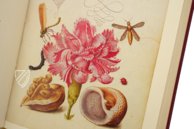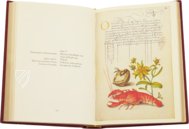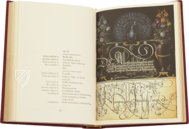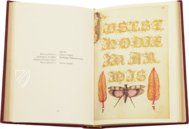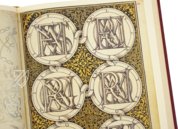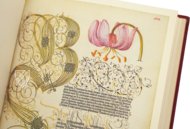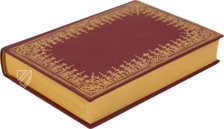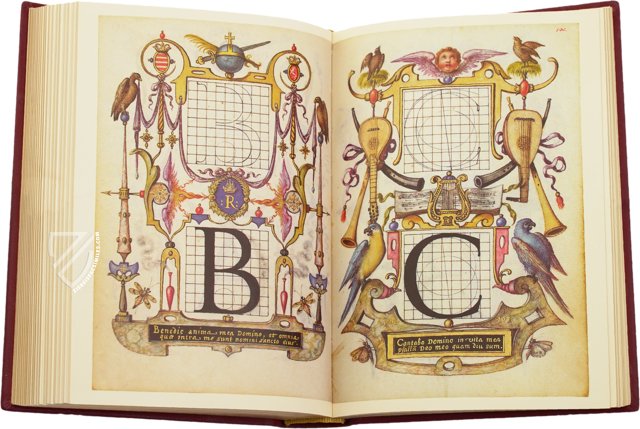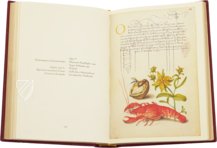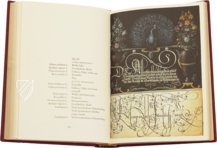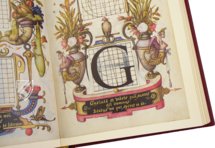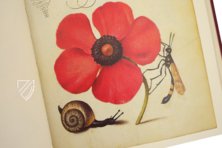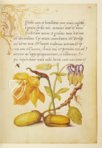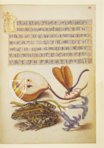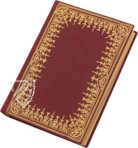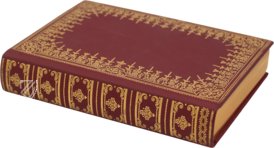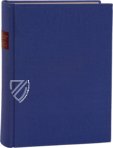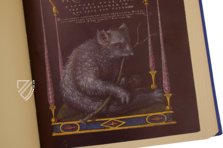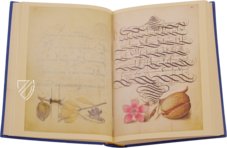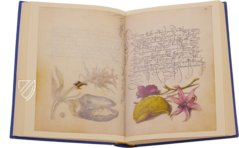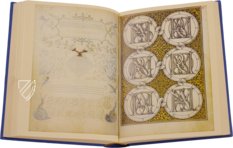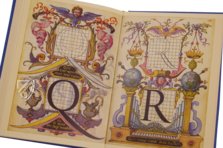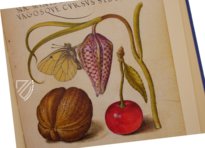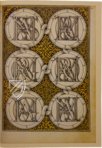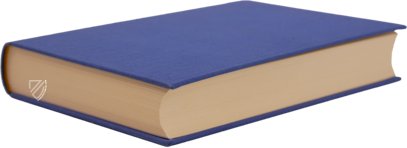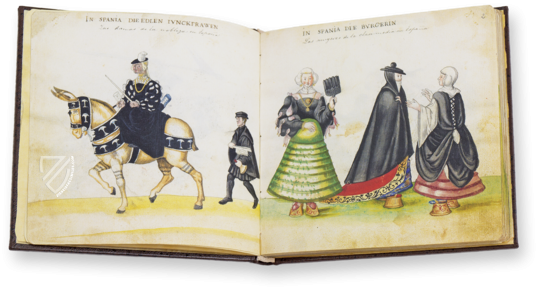Model Book of Calligraphy
(1,000€ - 3,000€)
The splendid Mira calligraphiae monumenta is simultaneously a magnificent work concerning calligraphy as well as one of the last great masterpieces of illumination from a time when manuscripts were being rapidly replaced by printed books. The imperial court calligrapher Georg Bocksay (d. 1575) began the work in the year 1561 at the behest of Holy Roman Emperor Ferdinand I (1503–64), whose grandson Rudolf II (1552–1612) would commission the Flemish illuminator Joris Hoefnagel (1542–1601), one of the last of his kind, to artfully adorn it in 1590. Two masterful hands are evident in this work, and they seem to vie with one another for who practices the higher art.
Model Book of Calligraphy
This fine work originated over the course of thirty years, resulting from generations of patrons and artisans alike, it was commissioned by Holy Roman Emperor Ferdinand I (1503–64) and completed under his grandson Rudolf II (1552–1612). The Mira calligraphiae monumenta is a splendidly adorned calligraphic model book originally written by Georg Bocksay (d. 1575), the imperial court calligrapher, and which was masterfully decorated after his death by Joris Hoefnagel (1542–1601). Hoefnagel’s illuminations are rooted in the Ghent-Bruges school of the 15th and 16th centuries, but also show signs of the emerging style of Netherlandish still life painting.
30 Years of Artistic Labor
After the project was originally conceived of by Ferdinand I, work began on the Model Book in Vienna between 1561 and 1562, when Bocksay laid down his masterful calligraphy on parchment, but it was not until 1590 that Rudolf II commissioned Hoefnagel with artfully filling out the pages. Soon the manuscript was filled with plants, fruits, flowers, animals, insects, and cityscapes. Large letters were constructed with hybrid creatures and fanciful masks. Hoefnagel was arguably attempting to assert the superiority of imagery over the written word at a time when the illuminated manuscript was a fast-dying book form. His artwork is a mixture of naturalism and illusionism: highly detailed, three dimensional depictions of apples cut in two and reptiles with iridescent skin. The imperial Kunstkammer or Cabinet of Curiosities provided models of various bones, shells, fossils, and other natural specimens for the artist to study up close. Finally, Hoefnagel employed a brilliant color palette as well as gold and silver to illustrate virtually every page of the manuscript, making him one of the last of the great illuminators.
A Highly Coveted Work
After its second imperial patron and owner died in 1612, the manuscript passed through various private hands before coming into the possession of the Austrian engineer and metalsmith Albert Milde in 1887. After passing through another set of hands, it was acquired by the German art collector Friedrich Ludwig von Gans in 1916. Two more private owners had this magnificent piece of Renaissance illumination all to themselves before it was sold in 1986 to the J. Paul Getty Museum, which had been aggressively collecting illuminated manuscripts since inheriting $1.2 billion dollars in 1982. It remains an important part of the fabulous collection in Los Angeles to this day.
Codicology
- Alternative Titles
- Mira Calligraphiae Monumenta
Kalligraphiebuch
Georg Bocskay's Model Book of Calligraphy
Sketchbook by Joris Hoefnagel - Size / Format
- 254 pages / 16.6 × 12.4 cm
- Origin
- Austria
- Date
- 1561–1562 and 1591–1596
- Epochs
- Style
- Language
- Content
- Model book with a section on the construction of letters
- Patron
- Ferdinand I
Rudolph II - Artist / School
- Georg Bocskay
Joris Hoefnagel - Previous Owners
- Ferdinand I
Rudolph II
Albert Milde
Friedrich Ludwig von Gans
Louis Koch
Model Book of Calligraphy
Idealized Nature
Here we see that this gorgeously executed manuscript is so much more than a calligraphic model book – it is also a fantastic specimen of the Northern Renaissance that blends naturalism and idealism with shadows suggesting a light source from the background. The frog’s green and black camouflage is depicted with a sheen indicating that it is wet while it sits alongside a blue lily. Meanwhile, a dragonfly with hairy legs lands upon the long stem of a freshly sliced pear.

Model Book of Calligraphy
Ten Commandments and Maypole Dance
This black dyed page presents the calligrapher with a lavish opportunity to show off his great skill. Only a true master would be entrusted with gold ink, which stands out wonderfully against the black parchment. The iron-copper solution used to dye the pages was itself expensive and difficult to create, and as such is extremely rare.
Above the text, a cloud appears to explode with a cacophony of light and thundering trumpets as Moses receives the Ten Commandments on two stone tablets. This scene from the Old Testament is contrasted by the pagan bas-de-page miniature, which shows an expansive landscape in which people dance around a maypole before a field of colorful tents and is presented as though painted on the side of a Roman sofa.
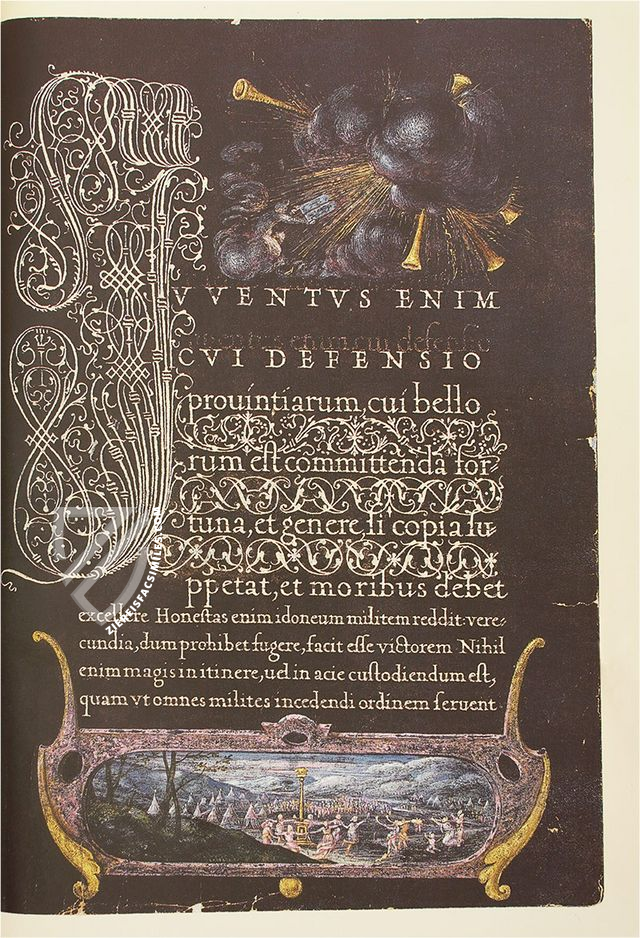
#1 Mira Calligraphiae Monumenta (Luxury Edition)
Language: German
(1,000€ - 3,000€)
#2 Mira Calligraphiae Monumenta
(1,000€ - 3,000€)
- Treatises / Secular Books
- Apocalypses / Beatus
- Astronomy / Astrology
- Bestiaries
- Bibles / Gospels
- Chronicles / History / Law
- Geography / Maps
- Saints' Lives
- Islam / Oriental
- Judaism / Hebrew
- Single Leaf Collections
- Leonardo da Vinci
- Literature / Poetry
- Liturgical Manuscripts
- Medicine / Botany / Alchemy
- Music
- Mythology / Prophecies
- Psalters
- Other Religious Books
- Games / Hunting
- Private Devotion Books
- Other Genres
- Afghanistan
- Armenia
- Austria
- Belgium
- Colombia
- Croatia
- Cyprus
- Czech Republic
- Denmark
- Egypt
- Ethiopia
- France
- Germany
- Greece
- Hungary
- India
- Iran
- Iraq
- Israel
- Italy
- Japan
- Lebanon
- Luxembourg
- Mexico
- Morocco
- Netherlands
- Palestine
- Peru
- Poland
- Portugal
- Russia
- Serbia
- Spain
- Sri Lanka
- Sweden
- Switzerland
- Syria
- Turkey
- Ukraine
- United Kingdom
- United States
- Uzbekistan
- Aboca Museum
- Ajuntament de Valencia
- Akademie Verlag
- Akademische Druck- u. Verlagsanstalt (ADEVA)
- Aldo Ausilio Editore - Bottega d’Erasmo
- Alecto Historical Editions
- Alkuin Verlag
- Almqvist & Wiksell
- Amilcare Pizzi
- Andreas & Andreas Verlagsbuchhandlung
- Archa 90
- Archiv Verlag
- Archivi Edizioni
- Arnold Verlag
- ARS
- Ars Magna
- ArtCodex
- AyN Ediciones
- Azimuth Editions
- Badenia Verlag
- Bärenreiter-Verlag
- Belser Verlag
- Belser Verlag / WK Wertkontor
- Benziger Verlag
- Bernardinum Wydawnictwo
- BiblioGemma
- Biblioteca Apostolica Vaticana (Vaticanstadt, Vaticanstadt)
- Bibliotheca Palatina Faksimile Verlag
- Bibliotheca Rara
- Boydell & Brewer
- Bramante Edizioni
- Bredius Genootschap
- Brepols Publishers
- British Library
- C. Weckesser
- Caixa Catalunya
- Canesi
- CAPSA, Ars Scriptoria
- Caratzas Brothers, Publishers
- Carus Verlag
- Casamassima Libri
- Chavane Verlag
- Christian Brandstätter Verlag
- Circulo Cientifico
- Club Bibliófilo Versol
- Club du Livre
- CM Editores
- Collegium Graphicum
- Collezione Apocrifa Da Vinci
- Comissão Nacional para as Comemorações dos Descobrimentos Portugueses
- Coron Verlag
- Corvina
- CTHS
- D. S. Brewer
- Damon
- De Agostini/UTET
- De Nederlandsche Boekhandel
- De Schutter
- Deuschle & Stemmle
- Deutscher Verlag für Kunstwissenschaft
- DIAMM
- Droz
- E. Schreiber Graphische Kunstanstalten
- Ediciones Boreal
- Ediciones Grial
- Ediclube
- Edições Inapa
- Edilan
- Editalia
- Edition Deuschle
- Edition Georg Popp
- Edition Leipzig
- Edition Libri Illustri
- Editiones Reales Sitios S. L.
- Éditions de l'Oiseau Lyre
- Editions Medicina Rara
- Editorial Casariego
- Editorial Mintzoa
- Editrice Antenore
- Editrice Velar
- Edizioni Edison
- Egeria, S.L.
- Eikon Editores
- Electa
- Emery Walker Limited
- Enciclopèdia Catalana
- Eos-Verlag
- Ephesus Publishing
- Ernst Battenberg
- Eugrammia Press
- Extraordinary Editions
- Fackelverlag
- Facsimila Art & Edition
- Facsimile Editions Ltd.
- Facsimilia Art & Edition Ebert KG
- Faksimile Verlag
- Feuermann Verlag
- Folger Shakespeare Library
- Franco Cosimo Panini Editore
- Friedrich Wittig Verlag
- Fundación Hullera Vasco-Leonesa
- G. Braziller
- Gabriele Mazzotta Editore
- Gebr. Mann Verlag
- Gesellschaft für graphische Industrie
- Getty Research Institute
- Giovanni Domenico de Rossi
- Giunti Editore
- Graffiti
- Grafica European Center of Fine Arts
- Guido Pressler
- Guillermo Blazquez
- Gustav Kiepenheuer
- H. N. Abrams
- Harrassowitz
- Helikon
- Hendrickson Publishers
- Henning Oppermann
- Herder Verlag
- Hes & De Graaf Publishers
- Hoepli
- Holbein-Verlag
- Hortus Deliciarum
- Houghton Library
- Hugo Schmidt Verlag
- Idion Verlag
- Il Bulino, edizioni d'arte
- ILte
- Imago
- Insel Verlag
- Instituto Nacional de Antropología e Historia
- Istituto dell'Enciclopedia Italiana - Treccani
- Istituto Ellenico di Studi Bizantini e Postbizantini
- Istituto Geografico De Agostini
- Istituto Poligrafico e Zecca dello Stato
- Italarte Art Establishments
- J. Thorbecke
- Jan Thorbecke Verlag
- Johnson Reprint Corporation
- Josef Stocker
- Josef Stocker-Schmid
- Jugoslavija
- Karl W. Hiersemann
- Kasper Straube
- Kaydeda Ediciones
- Kindler Verlag / Coron Verlag
- Kodansha International Ltd.
- Konrad Kölbl Verlag
- Kurt Wolff Verlag
- La Liberia dello Stato
- La Linea Editrice
- La Meta Editore
- Lambert Schneider
- Landeskreditbank Baden-Württemberg
- Leo S. Olschki
- Les Incunables
- Library of Congress
- Libreria Musicale Italiana
- Lichtdruck
- Lito Immagine Editore
- Lumen Artis
- Lund Humphries
- M. Moleiro Editor
- Maison des Sciences de l'homme et de la société de Poitiers
- Manuscriptum
- Martinus Nijhoff
- Maruzen-Yushodo Co. Ltd.
- MASA
- McGraw-Hill
- Militos
- Millennium Liber
- Müller & Schindler
- Nahar and Steimatzky
- National Library of Wales
- Neri Pozza
- Nova Charta
- Oceanum Verlag
- Odeon
- Orbis Mediaevalis
- Orbis Pictus
- Österreichische Staatsdruckerei
- Oxford University Press
- Pageant Books
- Parzellers Buchverlag
- Patrimonio Ediciones
- Pattloch Verlag
- PIAF
- Pieper Verlag
- Plon-Nourrit et cie
- Prestel Verlag
- Princeton University Press
- Prisma Verlag
- Priuli & Verlucca, editori
- Pro Sport Verlag
- Propyläen Verlag
- Pytheas Books
- Quaternio Verlag Luzern
- Reales Sitios
- Recht-Verlag
- Reichert Verlag
- Reichsdruckerei
- Riehn & Reusch
- Roberto Vattori Editore
- Rosenkilde and Bagger
- Roxburghe Club
- Salerno Editrice
- Sarajevo Svjetlost
- Schöck ArtPrint Kft.
- Scolar Press
- Scrinium
- Scripta Maneant
- Scriptorium
- Siloé, arte y bibliofilia
- SISMEL - Edizioni del Galluzzo
- Sociedad Mexicana de Antropología
- Société des Bibliophiles & Iconophiles de Belgique
- Soncin Publishing
- Sorli Ediciones
- Stainer and Bell
- Studer
- Styria Verlag
- Sumptibus Pragopress
- Szegedi Tudomànyegyetem
- Taberna Libraria
- Tarshish Books
- Taschen
- Tempus Libri
- Testimonio Compañía Editorial
- Thames and Hudson
- The Clear Vue Publishing Partnership Limited
- The Facsimile Codex
- The Folio Society
- The Marquess of Normanby
- The Richard III and Yorkist History Trust
- Tip.Le.Co
- TouchArt
- TREC Publishing House
- TRI Publishing Co.
- Trident Editore
- Typis Regiae Officinae Polygraphicae
- Union Verlag Berlin
- Universidad de Granada
- University of California Press
- University of Chicago Press
- Urs Graf
- Vallecchi
- Van Wijnen
- VCH, Acta Humaniora
- VDI Verlag
- VEB Deutscher Verlag für Musik
- Verlag Anton Pustet / Andreas Verlag
- Verlag Bibliophile Drucke Josef Stocker
- Verlag der Münchner Drucke
- Verlag für Regionalgeschichte
- Verlag Styria
- Vicent Garcia Editores
- W. Turnowsky
- Waanders Printers
- Wiener Mechitharisten-Congregation (Wien, Österreich)
- Wissenschaftliche Buchgesellschaft
- Wydawnictwo Dolnoslaskie
- Xuntanza Editorial
- Zakład Narodowy
- Zollikofer AG






